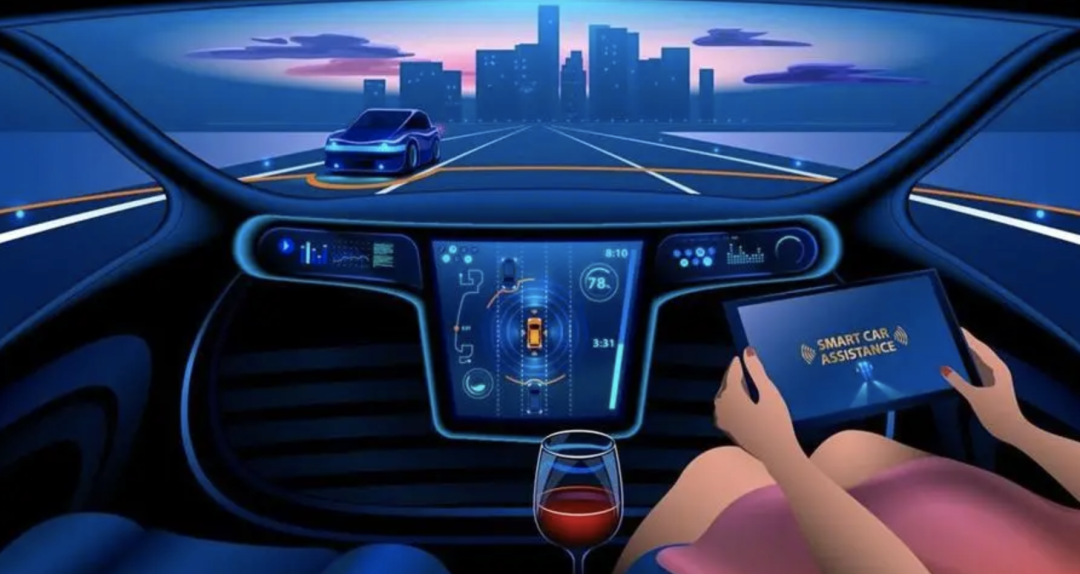Author: Chen Nianhang
The revolution of intelligent automotive is actually pushing the development of intelligent automotive software to a more important position in automotive research and development.
Nowadays, people are talking about “software-defined cars”, which refers to new electronic and electrical architectures, intelligent driving software, intelligent cockpit software, etc. These modules define most of the intelligent experience of cars, and many of the functions and modules can be updated through OTA and FOTA, making cars always new and improving the experience with software updates.
Therefore, you can see that Tesla and many domestic new car-making forces differ in their competitiveness in the ability of automotive software development. From competition in driving control and mechanical quality to now more emphasis on the ability of intelligent software, software ability is the homework that traditional car companies are trying to catch up on, and the transformation of intelligent electric vehicles is essentially the transformation of automotive software development.
However, most traditional car companies have encountered pains in this transformation process.
As the world’s largest automotive group, Volkswagen has been plagued by software problems.
In December 2022, it was reported online that the Volkswagen ID. series electric cars experienced black screens, loss of power, and other problems during driving. According to feedback from car owners, some Volkswagen ID.4 screens and instrument screens went completely black, and some even lost power without normal output. In addition, the ACC and LCC functions were all unavailable. Although the screen would recover after restarting the car or locking the car and then restarting it, it always displayed a fault code. SAIC Volkswagen responded that they had found a technical solution for these problems, and the issues need to be resolved in the future.
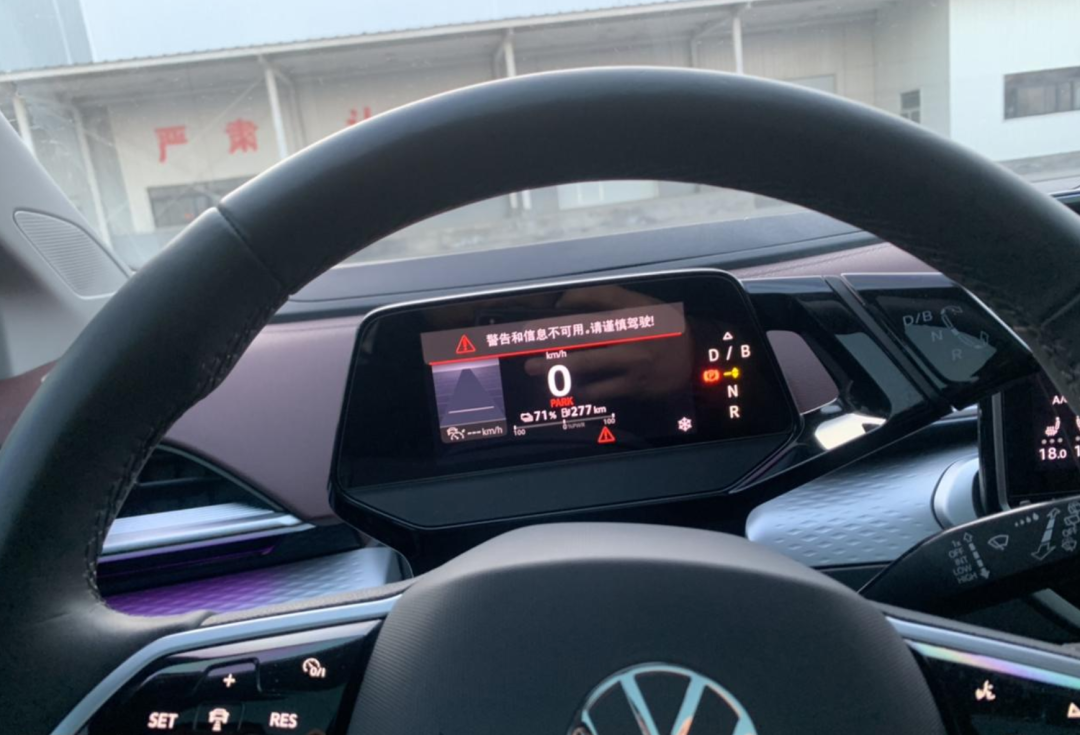
As early as the end of December 2019, when Volkswagen’s first “intelligent electric car” based on the MEB platform, the ID.3, was put into production for a month and the output was about to exceed 10,000, the Volkswagen Group discovered software problems for the first time — the ID.3 system had coding defects that prevented it from completing automatic software upgrades. The contingency plan was for Volkswagen’s engineers to manually upgrade the software for the malfunctioning vehicles, while the internal software team was mobilized to fix the software bugs on the ID.3. Fortunately, the outcome was positive, and subsequent ID.4 and ID.3 models were delivered smoothly.

At a critical moment in the transformation of intelligent electric vehicles, Volkswagen is undoubtedly an international car company with a very strong transformation intention. However, many times it is “more than enough and less than enough.” After all, as a traditional car company, it has many brands, numerous models, and a large organizational structure. In the past, it was good at machinery and hardware. It is difficult to turn the ship around in terms of software development. It needs to rely on its own long-term research and development accumulation and the common assistance of external suppliers.
In the era of software-defined cars, emerging Tier1 companies are needed by automakers
Not only Volkswagen is facing software problems, but most domestic traditional car companies are also facing a lack of accumulation in the development of automotive intelligent software.
Especially when vehicles are becoming more and more complex in software, including a large number of safety-related functions such as digitization, connection, and automatic driving functions. Automakers need deeper professional knowledge to ensure a stable software architecture and the best interaction between these functions.
Therefore, automakers need technology companies or Tier 1 companies specializing in automotive software development to help them.
In the current Chinese market, a batch of emerging software and hardware suppliers have emerged in fields such as intelligent driving and intelligent cockpit. They are either start-ups, such as Momenta, Horizon Robotics, and Hesai Technology, or Internet technology companies, such as Baidu IDG, Huawei Car BU, and Alibaba Banma Zhixing.
As a new, professional, and local Tier 1 specializing in automotive intelligent software, Baidu has launched a series of automotive intelligent products in recent years and has delivered them in mass production to many carmakers. Moreover, Baidu officially established the Intelligent Auto Business Unit in the second half of 2021, raising mass production delivery to an important position in the organizational level.
In terms of specific products:
-
In terms of intelligent driving, Baidu already has a variety of products such as autonomous parking AVP, ANP 2.0 for driving and parking, and ANP 3.0 for urban domain navigation assistance. These products have been delivered in mass production to many car models, such as GAC Aion Safety Series, Haval Sharper, Tank 500, Ora Lightning Cat, and WM W6. It is said that in the future five years, the shipment of these intelligent driving products will maintain an average annual growth rate of 100%.- Regarding intelligent cabins, Baidu has achieved large-scale production of Xiaodu Car and helped automobile manufacturers quickly achieve cabin intelligence, having served over 5 million car owners.
-
Regarding intelligent maps, in addition to navigation maps and high-precision maps, Baidu has also achieved mass production of human-machine co-pilot maps, and is expected to be installed in more models by 2023.
Up to now, Baidu’s intelligent solutions for automobiles have been mass-produced in 134 models of 31 automobile brands, including Ford, Lincoln, Cadillac, Buick, Toyota, Crown, Hyundai, Kia, Geely, Xpeng, BYD, and WM Motor, with a total of over 7 million vehicles equipped.
For a new Tier 1 company, such achievements are remarkable.
Behind these achievements, there are certainly many doubts.
Many people say that the new suppliers lack the deep accumulation of the automotive industry chain, making it difficult to meet the stringent requirements for in-vehicle use. Many OEMs will also be plunged into the dilemma of making choices when facing so many new suppliers without knowing their strength and whether they have the ability for long-term supply.
Improving this awkward situation is not easy. On the one hand, new suppliers need to prove their ability to supply the OEMs with qualified and compliant, stable software and hardware. Therefore, these suppliers are striving to meet the various requirements of vehicle regulations, and obtain more certification certificates from professional institutions in the automotive industry. On the other hand, OEMs also need to find the most suitable software and hardware suppliers based on the development needs of their own models and systems. They are also establishing their own quality acceptance standards while referring to the evaluation of authoritative third-party certification institutions in the automotive industry.
Nowadays, the intelligence of vehicles largely relies on software capabilities. The functions of intelligent driving and intelligent cabin become more and more diverse. Moreover, these functions cannot remain the same and need to be constantly iteratively optimized with new features to stay fresh. Therefore, the software development process for automotive industry in the new era requires very agile procedures. It is no longer a situation where a feature takes three years to define and mass-produce but cannot be upgraded for the next 10 years.
Software-defined vehicles imply changes in the overall structure and cost of the vehicle, and changes in risk points and quality risks. There will also be new security risks, information risks, and even network risks in the software code. A good supplier needs to have its own logic system to control these risks. After all, restarting a mobile phone when it crashes is easy, but a crash of a vehicle system can cause traffic accidents. The importance of software risk control grows exponentially.## How to control the risks of software development to avoid the software crisis and accidents, like Volkswagen? A complete development process control is required that ensures the quality control of each step, while leaving enough space for feature updates and software upgrades to ensure high development efficiency.
As an emerging intelligent automotive supplier, Baidu has done a lot of internal training and exploration over the past few years, and the most direct manifestation is obtaining certificates from industry and authoritative organizations.
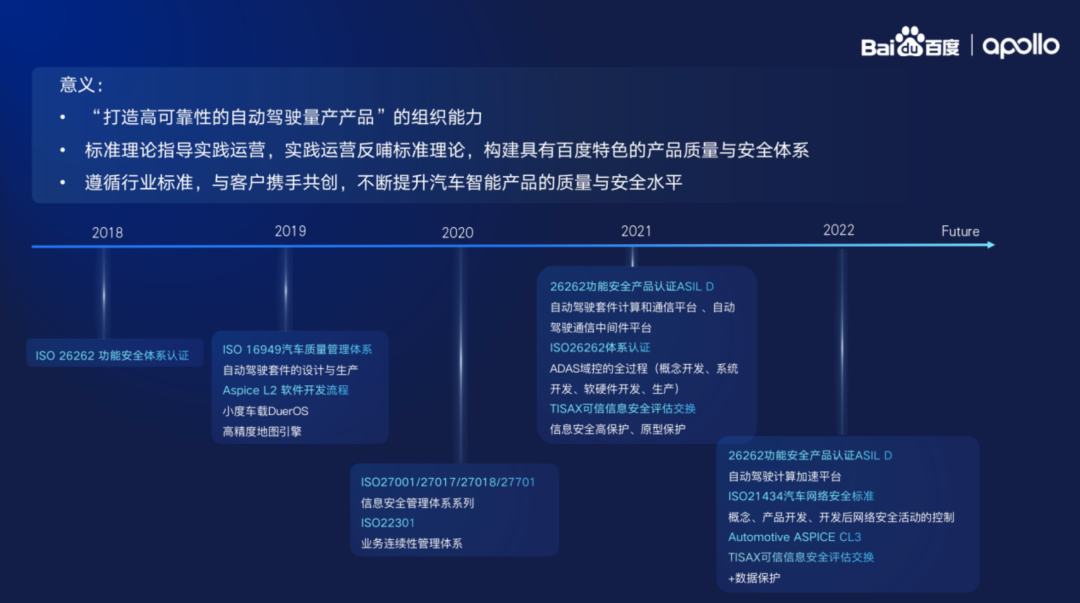
So far, Baidu has obtained ten related certifications and evaluations, including IATF 16949, ASPICE CL2/CL3, ISO 26262 system and product certifications, TISAX, ISO 21434, ISO 27001, ISO 27701, ISO 27017, ISO 27018, and ISO 22301.
IATF 16949 is a quality system standard commonly used in the automotive industry that nearly all Tier 1 suppliers must obtain to work with major automakers.
ASPICE and ISO 26262 are increasingly valued by major automakers and are essential for bidding on intelligent products. Currently, ASPICE CL3 evaluation and certification, which is the highest evaluation level the official has publicly announced and already acquired by Tier 1 in China’s automotive software field.
TISAX (Trusted Information Security Assessment Exchange) and ISO 21434, the road vehicle network security management system certification, are also focus points for future automakers.
What does obtaining these certifications mean for a Tier 1 supplier? It means that the supplier has been recognized for producing products with high quality in the mass production. When working with automakers, quality is guaranteed.
These industry standards can be seen as diplomas or entry passes. However, the supplier’s real strength lies in meeting the needs of automakers and providing good product experience for consumers. Obtaining these certifications is not the ultimate goal, but rather the result of focusing on the delivery of excellent automotive software production and delivery work, which protects and supports subsequent mass production and delivery work.Of course, obtaining a certification is not easy and requires long-term training, review, and practical certification. Recently, Baidu obtained ASPICE CL3 evaluation and certification, which has significant reference value for the certification process.
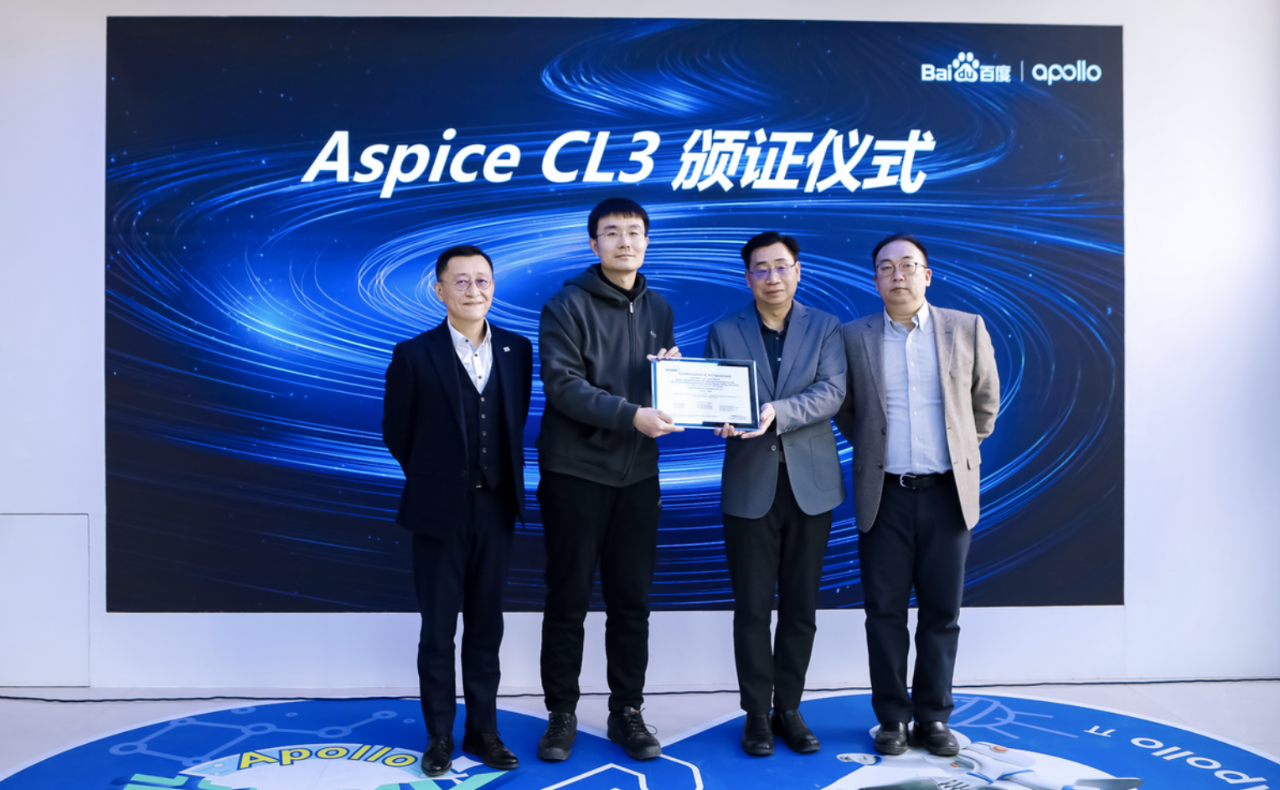
How did Baidu obtain ASPICE CL3 evaluation and certification, and what are the innovative points?
1. What is ASPICE CL3 evaluation and certification?
Let’s have a brief introduction to ASPICE CL3 evaluation and certification.
ASPICE stands for “Automotive Software Process Improvement and Capability Determination,” which is a model framework for the improvement of software processes and capability determination in the automotive industry. It guides the management and continuous improvement of research and development processes to ensure product research and development quality.
ASPICE is divided into 6 levels, and currently, many domestic Tier 1 mainly obtains ASPICE CL2 evaluation and certification, and a few obtain ASPICE CL3 evaluation and certification.
Level CL2 means that the project not only can complete the research and development work related to the product but also can plan and monitor all activities in advance, controlling the quality and changes of the product effectively, enabling the project to proceed in an orderly manner.
Level CL3 means that not only can each project be well managed, but also a company-level standard workflow can be established, forming the organization’s knowledge assets, which can guide the development of subsequent projects. Each project process can be trimmed from it, and the process can be continuously improved.
A simple understanding is that CL2 means you can do a problem very well, while CL3 means you can do all kinds of similar problems well and can learn from them to solve more types of problems.
Previously, Baidu had obtained CL2 evaluation and certification. Now, they have further achieved breakthroughs and obtained the CL3 certification.
As mentioned above, in the domestic automotive software industry, CL3 is the highest evaluation level officially announced by the government and obtained by Tier 1. Obtaining this level of evaluation means that Baidu has achieved a high level of project delivery process management and can provide high-quality and stable products and services to OEMs.Actually, besides Baidu, currently there are also Tier 1 such as Navinfo and Desay SV who have obtained the CL3 evaluation certification.
In November 2020, Navinfo’s high-precision map passed the ASPICE CL3 certification evaluation, and in September 2022, Desay SV’s Intelligent Driving Division also passed the ASPICE CL3 evaluation certification.
Why are so many Tier 1s competing to obtain this certification?
ASPICE was initially developed by more than 20 European automakers who recognized the importance of software quality, with the aim of guiding the software development processes of suppliers and improving the quality of automotive software.
Nowadays, with the vigorous development of automotive intelligence, this certification has become increasingly important. Many automakers will require this certification as a mandatory requirement when selecting software development suppliers, and it is an important criterion for whether or not an automaker chooses a certain Tier 1 as a supplier. Therefore, this also means real production orders for software.
It is not difficult to understand why both old and new Tier 1s are working so hard to obtain this certification.
2. Innovative aspects of Baidu obtaining ASPICE CL3 evaluation certification
Many people may say that since other Tier 1 can obtain CL3, it’s not surprising that Baidu can obtain it. However, this is not the case.
First, ASPICE CL3 evaluation certification itself is very difficult; second, Baidu also has important innovations in obtaining ASPICE CL3 evaluation certification.
Specifically:
On the one hand, the difficulty of ASPICE CL3 lies in integrating its management methods and processes into daily operations of organizations, rather than just completing a single project. It is very difficult to truly integrate these management methods and processes into the blood and bones of an organization, especially now that automotive intelligent software is becoming more and more complex, with various demands emerging one after another.
On the other hand, Baidu did not simply copy and apply the ASPICE CL3 evaluation certification, but combined the “V-model” development mode of the automotive software industry with the “agile development mode” of the traditional Internet and consumer goods industries, in an innovative way based on its own strengths and actual situation.
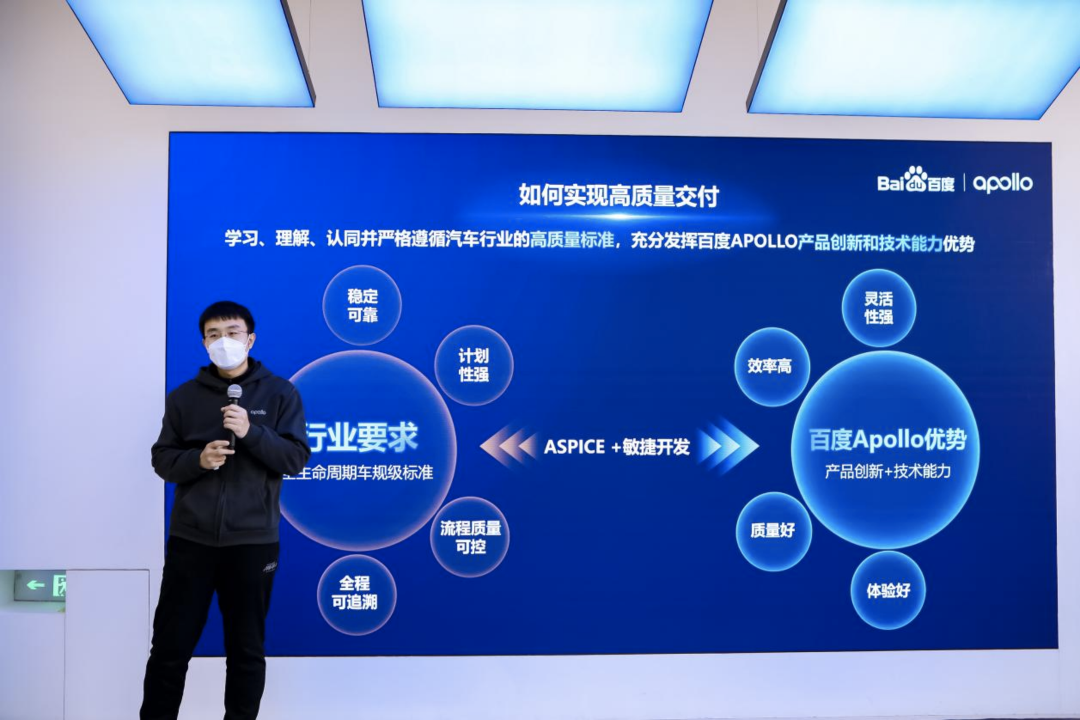 Here we introduce two concepts: “V model” and “Agile development mode”.
Here we introduce two concepts: “V model” and “Agile development mode”.
ASPICE certification evaluation is based on the traditional “V model”. The V model clearly identifies the various stages of software development and testing. Each stage has clear responsibilities, making it easier for enterprises to control the project as a whole and produce high-quality software products. At the same time, each stage of development has strict document requirements, strong traceability, and once problems arise, it is easy to trace the cause and carry out timely repairs.
However, there are also disadvantages to strictly following the regulations. Firstly, it is inflexible and not suitable for the variable requirements of intelligent automobile software development. Secondly, users can only see the development results at the end of the entire process, which leads to post-validation of requirements, making it difficult to ensure the user experience.
The “Agile development mode” is opposite to the traditional “V model”. Agile development takes the evolving user requirements as the core and uses iterative and incremental methods for software development. Agile development requires that requirements be clarified before development and tasks prioritized, and it can be multi-parallel, therefore having high development efficiency. When the project enters the substantive development iteration stage, users can quickly see the baseline architecture of the product and iteratively improve it with high flexibility and good user experience. Many intelligent driving functions of car companies, such as navigation assisted driving, are developed using the “Agile development mode”.
However, since Agile development focuses on communication between personnel, it may overlook the importance of documentation and make tracing problems difficult. In addition, it requires a high level of team capability, and the team needs members with strong experience to lead the team to continuously overcome bottlenecks, while also requiring team members to be stable and have strong collaborative abilities.
Now that the advantages and disadvantages of the two major models have been clarified, how does Baidu combine them organically?
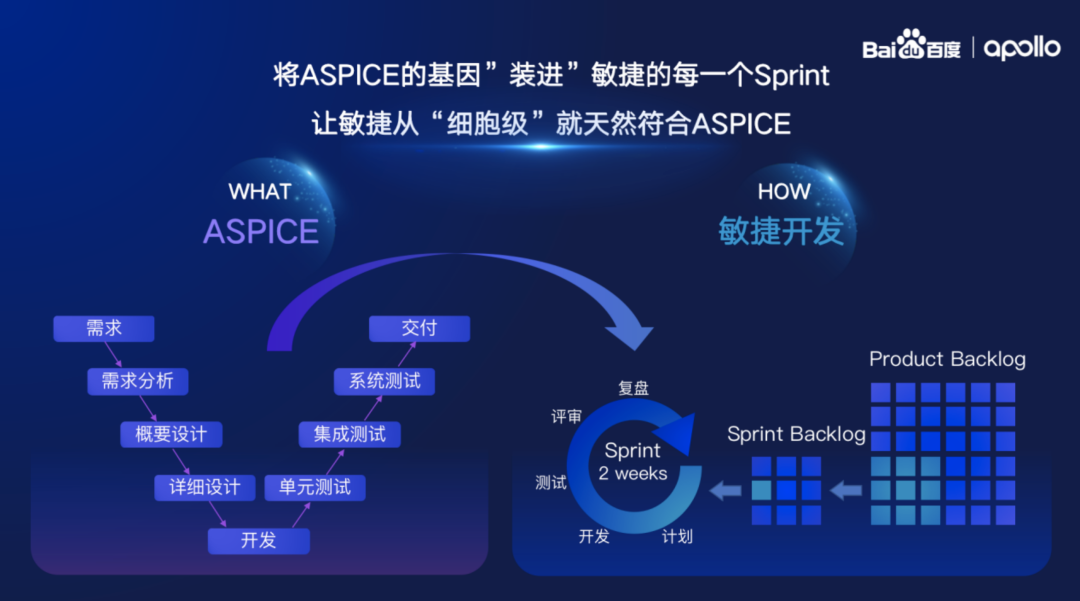
Baidu thoroughly disassembles the Agile development model and integrates ASPICE into each “iteration” of Agile development after transformation, making it naturally compliant with ASPICE requirements and achieving ASPICE CL3 standard evaluation.
Looking deeper, the development of automobile software has corresponding requirements, which may have about 70% certainty, and around 30% needs to be continuously replaced and updated through iterations. For the 30% of requirements that need to be iterated, the small V model can be used to ensure consistency and traceability of the development. Then, small V models are converged to form a large model, ultimately forming a complete and continuously iteratable software system.One-sentence summary: In the process of developing automotive software, Agile development is fully utilized, while the V model is integrated into each Agile development’s iteration (e.g., OTA-enabled functions) to make the entire development process more flexible. At the same time, it also meets the standards of ASPICE, resulting in high development efficiency, quality assurance, and rapid response to new requirements. As a result, Baidu becomes the first Tier 1 in the industry to deeply integrate the traditional V model (ASPICE) with Agile development mode.
Based on this, Baidu has also established a set of 3A (Apollo defined Agile based Aspice CL3) processes through actual project delivery practice. The 3A process system mainly serves the project delivery phase, with 17 subprocesses and over one hundred templates and case libraries, providing professional and standardized guidance for automotive software development projects. In the future, the 3A process will be widely promoted and applied in Baidu’s intelligent automotive product delivery projects.
By combining the automotive software development V model with the Agile development mode, winning the ASPICE CL3 evaluation and certification, Baidu has demonstrated the ability to mass-produce and deliver automotive software on a large scale, breaking the stereotype that Internet companies cannot do well in rules-level products. It can meet the diverse iterative needs brought by software-defined cars and become a good helper for automakers.
In fact, this also proves that Baidu is willing to take this system as a guideline and truly execute it according to requirements rather than becoming a decoration in the process of developing intelligent automotive products. This is very important, and this organizational effort and subjective initiative also demonstrate Baidu’s determination to be a Tier 1. Moreover, this entire process system is not static but needs constant iteration. Perhaps, Baidu can explore a more complete automotive software development methodology in the future.
Baidu continues to refine its ability to mass-produce intelligent automotive software
In addition to the ASPICE CL3 evaluation and certification, in the past few years, Baidu has also acquired nine industry-recognized certifications, which cover most stages and processes of automotive software development comprehensively. This progress has been steadfast without blindly pursuing speed.
In late 2018, the Baidu IDG created a Process Quality department, which builds process systems for research and development, commercialization, after-sales, and supply chain, and continuously improves them to promote the quality and safety of the intelligent driving, cockpit, and mapping product lines. Grinding the ax won’t delay the job of cutting wood. These process systems have become a “guide” for the research and development and mass production and delivery of Baidu’s intelligent automotive products.And driven by the Quality Department, Baidu IDG has obtained multiple industry qualifications, making itself a true leader in certifications.
As previously mentioned, Baidu has acquired up to ten relevant certifications and evaluations, including IATF 16949, ASPICE CL2/CL3, ISO 26262 system/product certification, TISAX, ISO 21434, ISO 27001, ISO 27701, ISO 27017, ISO 27018, and ISO 22301.
Obtaining these certifications is not the ultimate goal, but a natural outcome of the R&D process. Baidu still needs to prove its capability through the mass production stage. In fact, its mass production achievements in recent years have already demonstrated its capability to become a Tier 1 auto supplier for mature intelligent vehicles. As an emerging domestic Tier 1 in intelligent vehicles, Baidu is enjoying the dividends brought by the global transformation of smart electric vehicles, and has great potential for the future.
Next, Baidu will expand its capability to a wider battlefield, becoming a good partner and helper for auto companies to promote the transformation of intelligent cars in China and even globally. Baidu will make great efforts to push more intelligent functions into cars and benefit numerous car consumers.
If we compare Baidu to the old school international auto Tier 1 Bosch, Baidu will have the opportunity to become the “Bosch” in the future field of intelligent software development for cars. Although it’s a long way to go, the process system and capability of intelligent vehicle software mass production and delivery built by Baidu will escort the realization of this goal.
This article is a translation by ChatGPT of a Chinese report from 42HOW. If you have any questions about it, please email bd@42how.com.
